Letters From an Indeterminate Future: Remnants of the Archives of Reconfigured Past
Epistolary narrative, dialogism, intertextuality, speculative narrative — we imagine this text to be letters between the two of us across different temporalities, making use of a speculative and fragmented narrative in line with the themes we explore in our work: archiving the unarchivable, emotions, memories, and other human conditions within the horizon of extinction.
Dear N,
I wanna share with you several inspirations that visit me spontaneously in our endless present… Once there was… My kin kept this record, they found the remains of a disc from 1600 BC.
The fallacy of linear development! This wonderful Phaistos disc had remained until their time. No one knows its/their destiny. They kept this note also:
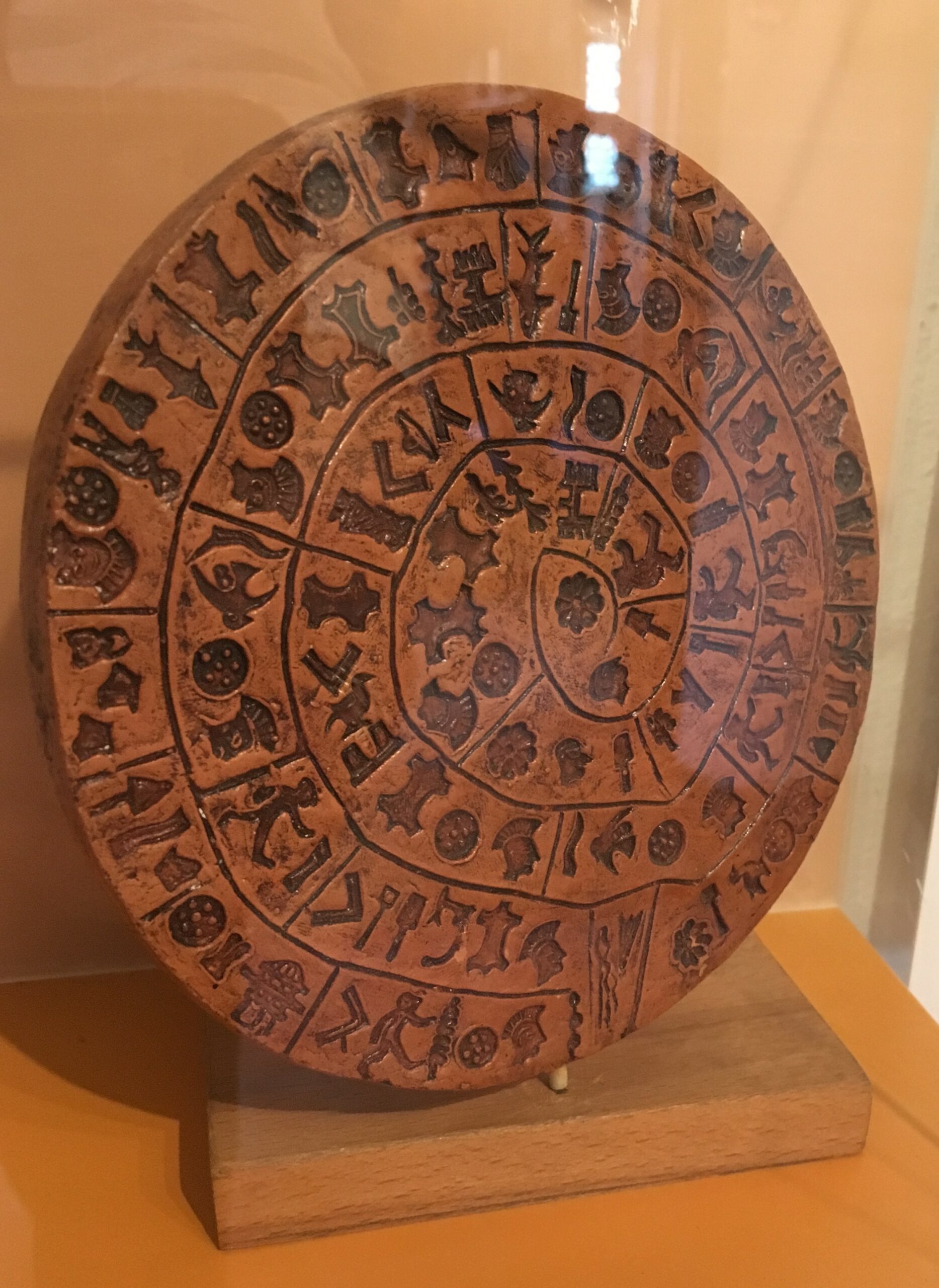
“On the disc of Phaistos there is a capacity for about 60 words or 137 bytes. Over 3000 years later, a CD has a storage capacity of 700 MB and is easily surpassed by modern media data storage. The capacity increases all the time; their sustainability is however always declining. But have we really, in the face of such growing quantities of data, so much more to say?”
In other pictures of the same disc from different angles, I saw a CD hidden strangely behind “our disc.” Have you heard about CDs by the way? You might remember that I have been investigating the lifespan of recording devices of the time. The most interesting ones for me are the films and videotapes. Ignorance about these antique technologies frustrates me. You cannot imagine what I have seen in these abandoned underground archives that remain inactive, locked, and uncared for. I found some records at one of their labs that still consist of digital players. I know how to use them and could see film footage of a gathering, possibly in the central continent of the time, I would say, from the end of the twentieth century. Here is a frame for you. I hope you see what grabs me in it…
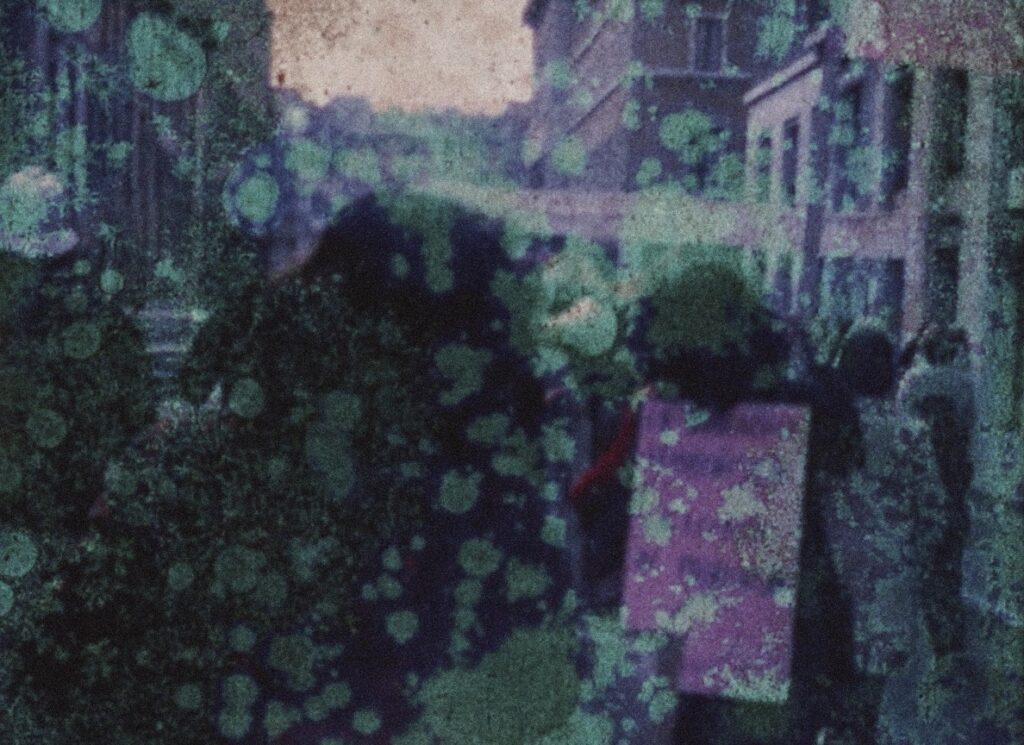
Even if they were digitized once, most of the images deteriorated. Do you see the residues of bacteria and mold? As mold ate into the emulsion, the images were noticeably and irreparably damaged. I see feathery-like distortions or dull spots on the projected image. I have found out that twenty percent of the magnetic tape deterioration occurred over a period of 10 to 25 years. An average videotape’s lifespan was only 30 years. The older tapes likely were affected by scratching or mold. This put tapes at much greater risk of poor picture quality.
Everything is fascinating in this crummy storage. I keep sneaking into the antiquated lab and no one has noticed me so far. You have to visit me if you are not scared of a possible raid by the cobots. It is so dark and dusty and full of strange boxes and tools. I feel like I regain the sense of time and unveil the past. I experience a rhythmic expansion of my cyborg being.
We have discussed the extinction together so many times. What terrifies me is that the timeframe I am investigating is the beginning of the most realistic claims over the extinction. Look what I have found in one of the qubit traces here. Probably from the beginning of the loss of the sense of time:
“As life-enhancing entanglements disappear from our landscapes, ghosts take their place. Some scientists argue that the rate of biological extinction is now several hundred times beyond its historical levels. We might lose a majority of all species by the end of the twenty-first century. The problem is not just the loss of individual species but of assemblages, some of which we may not even know about, some of which will not recover. Mass extinction could ensue from cascading effects. In an entangled world where bodies are tumbled into bodies (see our Monsters), extinction is a multispecies event. The extinction of a critical number of species would mean the destruction of long-evolving coordinations and interdependencies.”[1]
Surely, they wouldn’t estimate the latest pandemic distorted our perceptions of time’s passage leading to another extinction, the most terrifying disaster ever: massive amnesia. We lost the urge to record.
I am writing to you knowing that this moment will disappear eventually. And this fateful reality kills me: these moments never exist/ed per se. We must endlessly keep forming our guerilla collective in order to reclaim our sensations, a doorway into time through diagrams, cones, scales.
I keep leaking into this hole. This is for more than the things, discs, ghosts, and pirates. Eventually the disappearance of the disappeared.
Yours,
O
Dear O,
The end arrived as an orange hue. It filled our lungs with ash as we breathed the dead trees and their ghosts. They have grown inside our bodies, got pumped in our hearts, traveled across our veins. And now it is said that we are half-human, half-tree. Hybrid and monstrous, we are all stuck in this limbo.
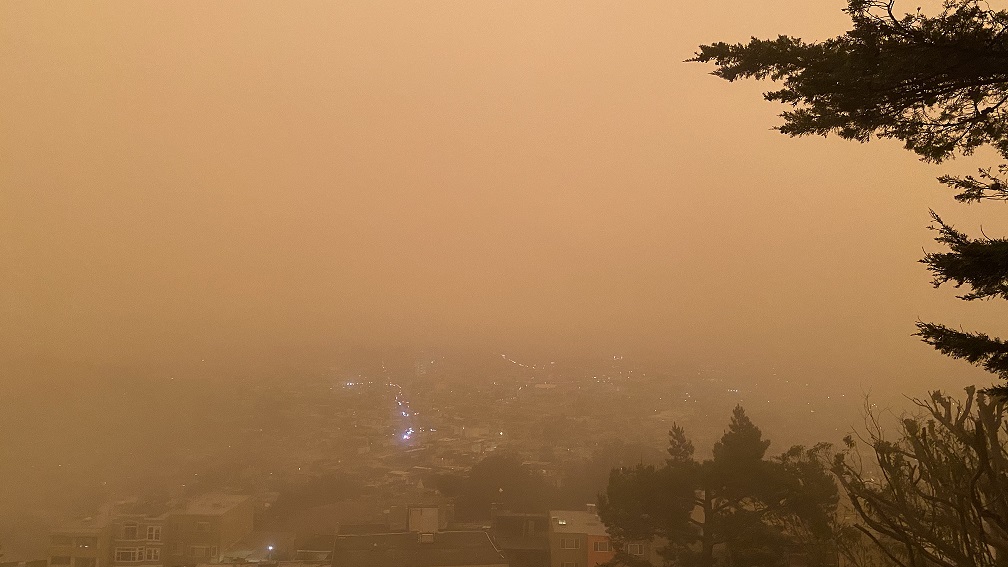
With a few other comrades we have been collecting memories, traveling across the oceans. Time is slow under water; you can hear your own ghost tree’s screams. We make bubbles with our own hands, splashing on the water, and then dive in to watch them take control. The light gets broken into a million pieces, and we feel alive for that half a second. Then, it will be gone again as a heavy melancholy sits on our shoulders. That heaviness is what Jalal Toufic calls “surpassing disasters.”
We nod at each other under the water; there is no need for a language. And language as we know it has been dead for so many years now. It is as if we are on the top of the Tower of Babel. The only thing we share is this physical space that our bodies take. We can feel the tower bending in the heavy wind and rain; we know our end is soon; there is nothing to talk about anymore. And even if we do, we are strangers to the sounds coming from our mouths. We can’t speak tree language; and we have no link to our previous life and culture. The vein is cut in this long history of exile.
We are illiterate. Our eyes are permanently blurred in forest fires. What we see is a total illusion; a fake copy of what we always believed to be reality. I think about the term muselmann[2], that you introduced me to in one of your letters, a lot. But I keep my thoughts to myself, as I watch exhaustion, starvation, or hopelessness take up empty space.
The memories we have been collecting are sticky and fluid. When you look closely at them, they are transparent, a million organisms touching each other, like the molds you describe in your letter. The first touch is gross but then you get used to it, as anything else in this world. Familiarity is a friend, and it builds over time. I think about these memories more as moods. They have different colors, according to their content, mixing into each other and forming colors I have never seen in my life before (or is this due to the blur?). It is difficult to explain but I feel a certain responsibility to the humans and nonhumans who have collected these in their brains, and who are not with us anymore due to the extinction.
Nowhere is safe anymore, politically and personally (the personal is political anyway). Hence, I carry these broken memories in my bag, which I keep close to my heart at night. An archive for the dispossessed. A complete ruin. And, as we discussed for so many hours in the past, the difficulty of bearing witness. I don’t know how long I can keep doing this. I am afraid that eventually I will have to let go, maybe somewhere under the ocean, in a millisecond of a splash, and then it will be like we had never existed, me and you, and the birds we loved, and all other strangers I encountered on this journey.
And I tell myself, maybe they did not want to remember these anyway? Who am I to hold power over these broken oral narratives and imaginations? Between the unsaid and said, between possibility and impossibility of speech. So now we arrive at this topography of grieving with you. Those communities are not with us anymore to activate these memories. So, what is the point anyway?
The phantoms of war, trauma, and disaster haunt me at night in my dreams. I have an archive fever of 104°C — as the tree in me keeps burning still.
I’d love to visit you in your hole one day.
Love,
N
Dear N,
We are on the margins of hauntology: “not even nothing can be free of ghosts.”[5] All entangles the effects of nuclear warfare: troubling time. I keep excavating in this hole to unfold the unarchivable, this was what the archive had expected, wasn’t it? Not statements but affects…
Thinking about the myriad compilation of the bits of your fluid memories — personal memories stuck in an endless present — merging with the DNA fingerprint as an embodied memory of Xs. The voyage of bits from Phaistos disc to DNA as a living archive was aporetic though.
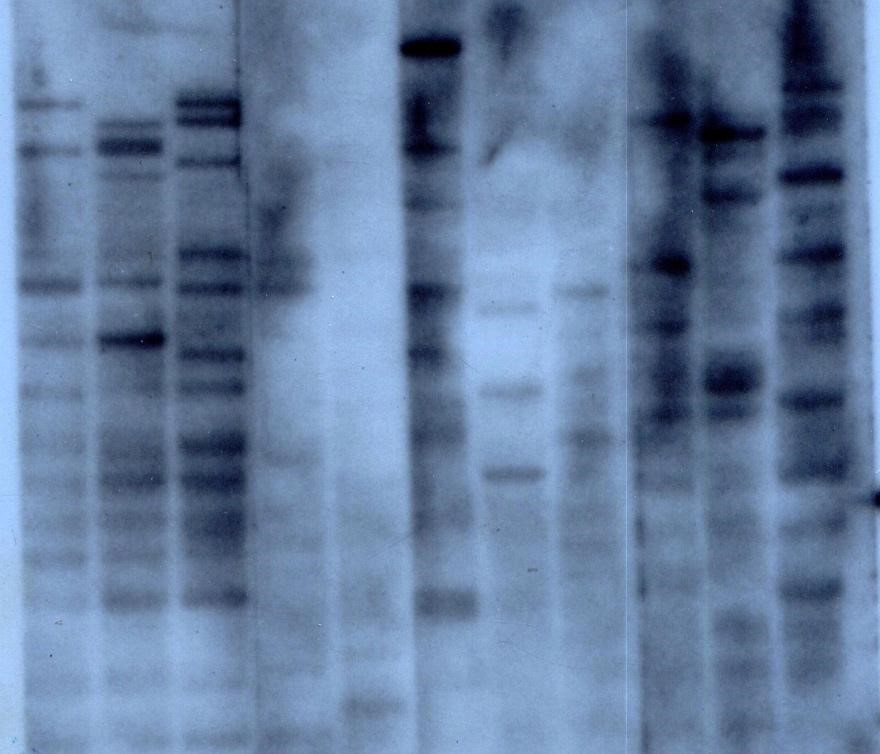
“Bioengineers George Church andSriram Kosuri used standalone DNA itself as their data-storage vehicle and found they could lodge 700 terabytes on a single gram. The binary pairs of DNA nucleotides function as bits, 0’s and 1’s, so that they can treat DNA as just another digital storage device.”[6]
Since the virus started to attack the humans’ dorsolateral, prefrontal right cortex, this project collapsed. An endless fight with neurons, acids, and molecules causes the loss of the sense of time. No need to preserve, no storage anymore. I smell the burning chain of molecules, or is it just a dead tree?
… “sense of loss, of what William Gibson calls the Gone World: ‘Somewhere, surely, there is a site that contains … everything we have lost,’ he suggests, and it is not clear whether he believes one could actually find it.”[7]
Our guerilla collective hacks the diagrams. Space, matter, and time. The essence of metaphysics in virtuality is based on a logical correlation of sujet, its durée, and memories. The existence is the eternity of life while it is the sum of durée. The essence of temporality. Archives are expected to leap over it per se.
“An infinite number of diffractions”[8]
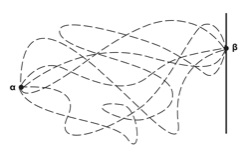
Quantum principle of ontological indeterminacy. Space, matter, and time. And void: “Virtuality is the indeterminacy of being/nonbeing, a ghostly non/existence. The void is a spectral realm; not even nothing can be free of ghosts. Virtual particles do not traffic in a metaphysics of presence. They do not exist in space and time. They are ghostly non/existences that teeter on the edge of the infinitely thin blade between being and nonbeing. They speak of indeterminacy.”[9]
All has been entangled with the effects of nuclear warfare for some centuries. The virus proliferates. Neurons lost the fight. Time distorted, the ghosts have remained. Yet, dwelling in this hole, only rabbits are allowed to pass the continuous march of time.
“And if you go chasing rabbits
And you know you’re going to fall,
Tell ’em a hookah-smoking caterpillar
Has given you the call.”[10]
Much love,
O
Dear O,
What is the memory made of if not abstractions, accumulation of time, emotions, lies (we tell ourselves and others), and tactile sensory experiences? And what do we forget if not the pain, the uncomfortable, a willful forgetting, un-accidental at its best?[11] What is left of it if not a residue, a mark of a past that never was?
As an archivist at the end of the world, the role assigned to me was to collect at all costs. It is a position of privilege to build narratives, to have access to the power to decide what should be remembered from this moment, and to make sure that it gets distributed to the ones coming after us on this planet. It is a human urge to believe that we are eternal, even at the age of extinction.
Coming from a family that lost all its memories due to a population exchange after the war, I knew that what will eventually get transferred is a moment of silence that floods from one generation to the other, like water, like a natural disaster. That is the cost for love we are not willing to pay, losing our tongues, becoming blind, losing taste as a whole cord of culture and rituals gets cut.[12] A cut that is deep, but without any scars on the flesh.
As it is too painful to remember, we dug our heads in the soil, made jokes about it (humor as survival), or just lost ourselves in the steepness of the time slope, maintaining life, running errands, muttering words that only circle around the real issue hidden in the back of our brains, somewhere behind our eyes. Our dreams would tell us about it, in the form of a prison, which is also a school, and we would analyze it for hours. That is the hierarchy of knowledge, we would conclude and move on.
Without the language, the sirtaki, the recipes for kibbeh, we were rootless. There was only a story of a man who was tortured in a cell somewhere in Anatolia, accused of being a Bulgarian spy, dying young. And a ring that was believed to belong to him, on my finger, reflecting my imagination of this story back at me, over and over again — and who would archive this ring?
We reinvented ourselves as hybrid beings, that is beyond identities, memories, on this island of pain. Half-human and half-tree, now we are untamable and fluid creatures. Can a normative archive hold our dynamic unbecomings?[13] How can we challenge the linear understanding of time, but make an archive that is cyclical in nature? I believe that we need a speculative methodology to do so. What is history if not a mythological narrative, but written by the one with privilege rather than those underrepresented ones? Hence, this archive that I am building should open up space for metamorphoses and symbols. I should finally let go of the control and the willingness to organize and tidy up, but rather embrace chaos and imperfections. This is an archive of not only the facts, but also those moments imagined, one that can hold rings, illusions, reflections, and ghosts. One that can allow a tentacular thinking between humans and their nonhuman allies, unexpected relations, threads between objects, moments, and everchanging individualities.[14] This is an archive that contradicts itself — analytical thinking is a privilege, and metaphors are methodologies of survival for identities who do not fit into boxes.
Imagine an embodied archive that is beyond bodies, and full of desires, fears, frustrations, competing truths. In fact, I quit my job as an archivist today, since I cannot bear this power anymore. Rather I become a part of this archive, becoming-with, towards a world-making practice that is speculative and ecofeminist. This is the day I finish my transformation into a banyan tree. I will strangle my host tree, but I will also give life to many others.[15] I hope my roots reach out to yours one day under the ground, feeding each other generously.
Until then, stay safe!
N
This contribution is published in the framework of the Whole Life Academy as part of the workshop “Archival Burnout in the Age of Vulnerability: [Disobedient] Commons and their Dilemmas, Speculations, Emotions”.
- Elaine Gan, Anna Tsing, Heather Swanson, and Nils Bubandt, eds., Arts of Living on a Damaged Planet. University of Minnesota Press, 2017, p. 4. ↑
- Muselmann term is from Giorgio Agamben, Remnants of Auschwitz: The Witness and the Archive. Zone Books, 2002. ↑
- Labyrinthine time is from Pelin Tan, “Surpassing Disaster: Haunted by an Imaginary Smyrna,” e-flux Journal, issue #118 (2021). ↑
- Jalal Toufic, The Withdrawal of Tradition Past a Surpassing Disaster. Forthcoming Books, 2009. ↑
- Karen Barad, “Troubling Time/s and Ecologies of Nothingness: Re-turning, Re-membering, and Facing the Incalculable,” New Formations, 2017, p.77. ↑
- Rebecca Lemov, “Archives-of-Self: The Vicissitudes of Time and Self in a Technologically Determinist Future,” Science in the Archive Pasts Presents Futures, ed. Lorraine Daston. University of Chicago Press, 2017, p. 262. ↑
- Lemov, “Archives-of-Self,” p. 265. ↑
- Barad, “Troubling Time/s and Ecologies of Nothingness,” p. 67. ↑
- Barad, “Troubling Time/s and Ecologies of Nothingness,” p. 78. ↑
- Jefferson Airplane, White Rabbit, the lyrics. ↑
- Sigmund Freud, Psychopathology of Everyday Life (Zur Psychopathologie des Alltagslebens), 1901. ↑
- Etel Adnan, On Love and the Cost We Are Not Willing to Pay Today. Hatje Cantz Verlag GmbH & Co KG, 2011. ↑
- Jamie Ann Lee, “A Queer/ed Archival Methodology: Archival Bodies as Nomadic Subjects,” Critical Archival Studies, special issue, Journal of Critical Library and Information Studies 1, no.2, 2017. ↑
- Inspired by Ranu Mukherjee’s artwork A Bright Stage, 2018. ↑
- Donna J. Haraway, Staying with the Trouble: Making Kin in the Chthulucene, 2016. ↑
Connected Material
Chto Delat’s installation Canary Archives employs the imagery of the canary in the coal mine, once used to alarm miners when carbon monoxide levels rose. Where is the canary today, that tells us wether the danger is real? It seems to have gone silent, the sharpest signal it can send. In an emergency newspaper issue under the impression of the Russian war on Ukraine, Chto Delat assembles anti-war views of artists and critics and expresses their solidarity with the Ukrainian people.
The legacy of anti-colonial leader and Pan-Africanist revolutionary Amílcar Cabral (1924-1973) still calls for cultural readings, and not strictly political ones. Contemporary art, so-called “artistic research” and critical theory will benefit from a cross-disciplinary approach which puts Cabral as relevant to art or which turns Cabral’s many contributions into tools.
This video interweaves the mobility of defiance against national-colonial borders and the collection of gossips by Southeast Asian migrants in Berlin.
Interrogating the archive of “green” extractivism is not just about uncovering access to knowledge, legal knowledge, for example, that can help expose (ecological and economic) crime and that can thus be a starting point for empowering true alternatives and thus alternative ways of living and organizing economic processes. It is also about creating a resonant space for shared thinking and reflection.
Accumulation and multiplication of images is an accumulation of the hidden histories behind them. How do we recover these invisible histories?
CLEPTOCRAZIA is an art and science festival curated by Valeria D’Ambrosio at Villa Romana in Florence. The project aims to disseminate knowledge on the roots of the environmental crisis through a cycle of lectures, screenings and performances with the contribution of international artists and scientists.
Scanning the Horizon works with and towards the seemingly unattainable, yet powerfully generative utopian demands of queer life set out on the horizon.
This collective chain uses multiple entry points to reflect on the encounter of archival practices, objects and material with non-linear timelines.
This workshop addressed archives as related to overlapping sites of nature/culture, climate change, deep time, and the built environment. The following texts and visual materials offer insight into individual participants’ research on
What does it mean to do archival research in embodied ways? Where is ‘the archive’ located in such an approach? And how might the open form of ‘the score’—a provisional map, a musical or performance score, a speculative cartography, an image atlas, a set of instructions—offer possibilities for articulating and transmitting the knowledge of elusive archives?